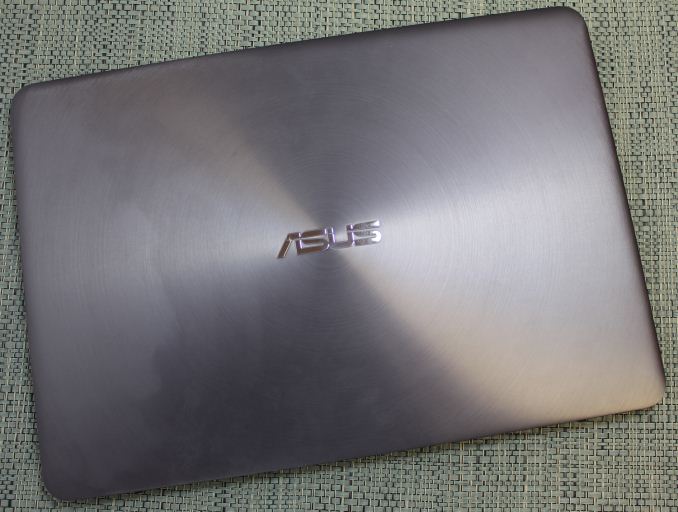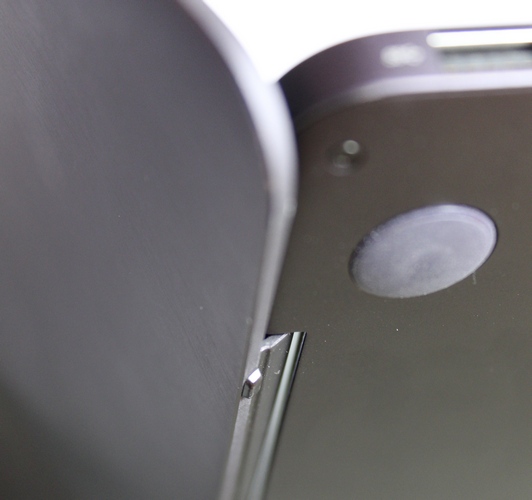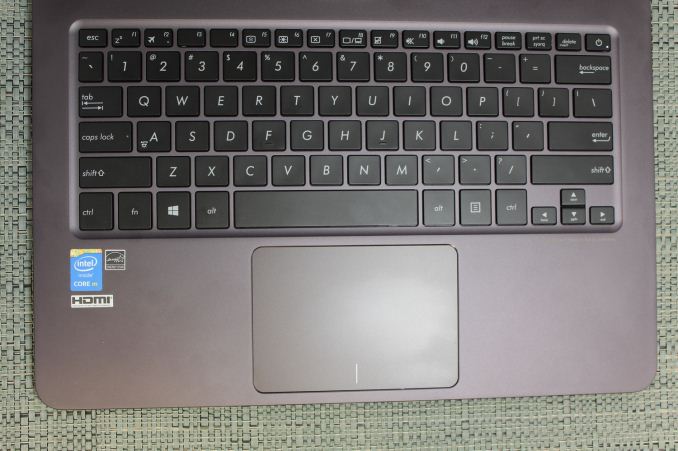The ASUS Zenbook UX305 Review
by Brett Howse on March 25, 2015 8:00 AM ESTDesign and Chassis
People who have seen or used any of the ASUS Zenbooks in the past will be familiar with the overall theme of the design, but the UX305 certainly sits apart from the rest of the lineup. It keeps the beautiful all-aluminum chassis, and the concentric-circles surrounding the ASUS logo on the lid. What sets the UX305 apart is how incredibly thin and light it is. At just 12.3 mm thick, and 1.2 kg in mass, the UX305 just wants to be taken with you. It has a very premium feel with the cool sensation of the aluminum which really makes you forget how little this laptop costs.
ASUS has paid a lot of attention to detail on some aspects of the UX305. One that struck me instantly was opening the lid, which is something many devices do not get right. The UX305 has a very light touch to the hinge, allowing you to open it with just one finger despite the device’s low mass. Of course, the optional touch model will need to have more tension in the hinge, so hopefully they pay as much attention to detail with it as they do the non-touch model. The display will open to 128°, which is a reasonable amount for a traditional notebook computer, but what is strange is the reason for the limited angle on the UX305.
Unlike most devices, the UX305 has a rear hinge which is not attached at the bottom of the display. The hinge attachment on the display is shifted slightly upwards towards the top of the display. This means that when the display is opened, it shifts behind the laptop, and then under it, raising the back of the laptop slightly as it moves from resting on four rubber feet, to the two front feet and the bottom of the display. The display will eventually stop at the maximum opening with the rear of the laptop slightly raised.
This is not the first device I have seen that does this, but it is far from ideal. The laptop has four rubber feet with plenty of grip, but the lid design means that the rear feet are no longer touching the surface. ASUS has prevented the aluminum edge of the display from being the contact point by adding to small plastic nubs on the back of the panel which end up being the feet when the laptop is open. This means that when I am using the UX305 on a soft surface like a wooden table, it can dig in a bit, and on a hard surface it will be less stable than when the four rubber feet are holding it up. To be honest it seems to serve no purpose at all. If it was for increased cooling, ASUS would be better served with a slightly thicker foot. It is certainly not for ergonomics.
Moving on, once the display is open, you can see the island keyboard which is surrounded by the aluminum keyboard deck. The edge of the wrist rest is slightly beveled, which helps a lot from the sharp edges of the aluminum biting into your wrists as has been known to happen on some Zenbooks. While not quite as comfortable as one of the soft touch keyboard decks, there has to be something said about the feel of the cool aluminum when typing. It all feels very premium. The keyboard is good for an Ultrabook, and I could type comfortably on it. Key travel according to ASUS is 1.5 mm. The keyboard layout is very standard, and the only thing that I dislike about the keyboard is that the power button is located on the top right corner above the backspace, and beside delete. Accidentally hitting it will power the device off of course, so it is not ideal. I did not have this happen to me during my time with the ASUS, and this is a common design on the Zenbook series. I think ASUS should move it, but they seem to like it there.
Really the only missing thing on the keyboard is backlighting. Premium devices generally have this, so it is confusing that the ASUS does not until you think about the price. The ASUS feels very premium, so in your mind it should have backlighting, but then you have to remember that this is a lower cost entry, which keeps higher cost items like 8 GB of memory and a 256 GB SSD, so to hit the price point they did some sacrifices were made, and backlighting was one of them.
The trackpad is quite large, and easy to use. It is 105 mm x 73 mm (4.13” x 2.87”) and there were no issues with usability. Tapping was never an issue, and two-finger scrolling worked well. The surface is very smooth and easy to glide over. The driver for the touchpad is provided by ASUS, and it seems like they are trying to move away from some of the poor touchpad experiences that have bitten them in the past. There is of course plenty of settings for various gestures to be enabled or disabled, and the left/right click can be reversed. My experience with the UX305 was that it was not the best touchpad I have ever used, but it is close. The drivers combined with the large surface area made the UX305 very easy to use.
The UX305 has a full complement of ports on the side, with two USB 3.0 ports on the left along with a SD card reader, and a third USB 3.0 port on the right along with the power connector, headset jack, and micro-HDMI port. There is of course no room for an Ethernet port on such a slim device, but ASUS is nice enough to include a USB 3.0 Ethernet adapter in the box. For those that need it, this is a nice bonus.
The speakers are downward firing through two grilles on the bottom of the device. Each speaker is 25 mm x 9 mm x 3 mm (meaning they are not round) and are set in a 1.7 cubic centimeter housing. ASUS has even gone to the trouble of ensuring the speaker wire length is equal on both sides. We will see later how well they perform.
The design of the UX305 continues in the tradition of the Zenbook, and is really a beautiful machine to look at, pick up, and use. The design is not perfect, mostly due to the display being used to elevate the device when open, but this is a relatively small thing when you consider the premium materials used to construct this very thin, and very portable device. When you consider the price point, ASUS has done a fantastic job overall.
















164 Comments
View All Comments
Klug4Pres - Wednesday, March 25, 2015 - link
I don't know why people want to buy these thin & light machines. What is wrong with a 5 lb laptop with a 35 Watt CPU, four RAM slots, two spindles, 14.1 inch 4:3 SXGA+ screen etc.? I keep being told "the ship has sailed", but I have no idea why.Novacius - Wednesday, March 25, 2015 - link
If you're traveling a lot or just have to take your laptop with you every day, you appreciate a lighter laptop. Very, very much. They also have much better battery life.Ian Cutress - Wednesday, March 25, 2015 - link
I used to carry a 4kg laptop with extended battery, 1200p screen etc to events like Computex and day trips/meetings for a couple of years. Put it this way, I'm glad I have a UX301 now at just over 2lbs. That being said, there are a few lighter weight systems that have me interested, like the LaVie Z that we saw at CES.Refuge - Wednesday, March 25, 2015 - link
I am the definition of a desktop replacement buyer.But even I see the relief in pulling out a 2lb feather on an airplane rather than some 17in 7lb beast.
Although those days are even coming to an end. Now you want a desktop replacement, the new Gigabyte P35X is a perfect idea! Thin, light, and TONS of horsepower. :)
Flunk - Wednesday, March 25, 2015 - link
If you want light and power I'd recommend getting a desktop AND a thin and light notebook. Why? The compromises necessary for thin and light notebooks are not compatible with the idea of a powerful notebook. Because of this you have to make a lot of compromises when it comes to heat, battery life, performance, price. At some point it might be possible but you can't get the best of both worlds right now.killeak - Wednesday, March 25, 2015 - link
Well, I disagree. As a render programmer that travels and works remote a lot (once every two months as minimum) I need a powerful laptop to work with. And the true is that these days there is plenty of great options that give you both (portability and performance). Recently I bought a Clevo p650sg (i7 4720hq, 980m, 32gb RAM, 2xSSD 500 + HD 1tb) for 2k usd. That being said, I do have a modern desktop PC at home that I bought last year (i7 4790, 16gb RAM, 500gb SSD + 2tb storage and a GeForce 770), but I prefer to use my laptop (I also bring it to the office and I plug to monitors and keyboard to increase my productivity). Performance wise, I will say that there is not much difference between my new laptop and the desktop that I use, in fact my new laptop is more powerful than my desktop at work except for the CPU (4770, 16gb RAM, 256 SSD and geforce 760).I love to have the performance of a powerful desktop in 2.6kg (before I had a Lenovo Y500, not that powerful but close and same weight). These days I use my desktop pc at home more as a media server and some occasional gaming on the TV than for work or main gaming platform (in any case I play SC2 and Civ5 mostly and I can play those on my laptop, even my old one).
That being said, I do see the point of ultrabook or hybrids. I also have an Asus T100 that I use as my true mobile laptop/tablet that I bring with me everywhere. For web surfing, mails, word/excel, watching movies/series at the airport/airplane, etc. is great, and battery life is awesome. I see myself buying a Surface Pro 4 or something like it in the future, to replace the T100, but not for actual work since I need a true i7 (not ULV), lot of ram and a powerful GPU, that I can bring with me when I travel.
Refuge - Wednesday, March 25, 2015 - link
I disagree, but only half.While you are correct and if you want power then there is no better solution than a full fledged desktop.
But you can't say that Laptops can't be defined as powerful when it is toting a 4ghz I7 with a GTX 980m. That is like saying a Corvette isn't sports car because it isn't a Ferrari. Laughable I know right?
Either way, broad stroke generalizations like that are quickly falling apart with each passing year as they cram more and more power into smaller and smaller packages. Anymore you are really only lacking in personal upradability. Which I can see being a big enough problem to turn people towards a desktop form factor of some sort.
andrewaggb - Wednesday, March 25, 2015 - link
I mostly agree, I've done the 17" laptop with dedicated graphics. It quickly lost it's ability to play the latest games with high settings, and eventually do play the latest with reasonable settings. It's battery life sucks, it's heavy, it's useless on an airplane, etc.It was handy for gaming on vacation though. I've been tempted to buy 2 new laptop's, another gaming/big screen 17" laptop and a 12 or 13" ultralight. They're both laptops, but they serve completely different purposes.
Conficio - Wednesday, March 25, 2015 - link
Working with two machines brings a lot of hassles of its own. Installing apps twice, upgrading twice, synching data, etc. having more storage on the desktop means you have to be selective and then you go the wrong selection on the road.I'd wish I could have an OS that has a seamless cloud extended storage, synching apps and documents a I need. Did I describe ChromeOS here?
kingpotnoodle - Wednesday, March 25, 2015 - link
Because (very obviously) if you don't need a powerful machine but you do a lot of travelling then it's much better to have a lighter machine with a long battery life. Most of my work is web/ssh/rdp, long battery life and lighter weight are FAR more important to me than it being able to play Crysis or do video editing lightning fast.